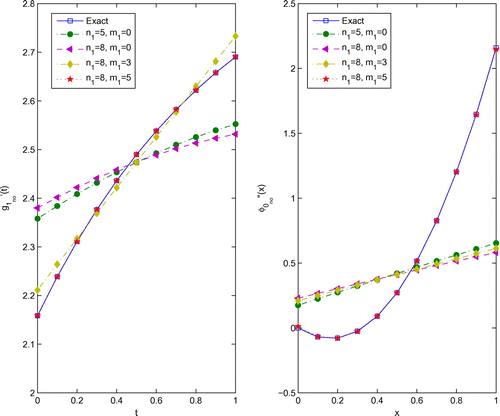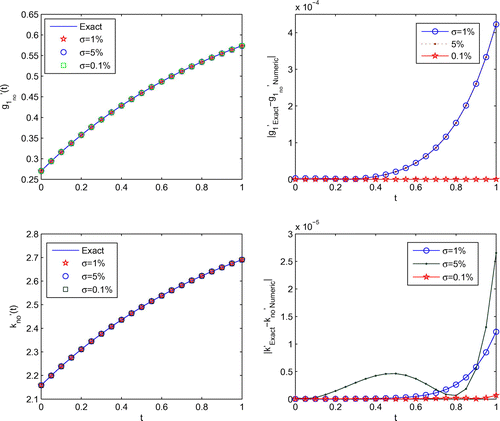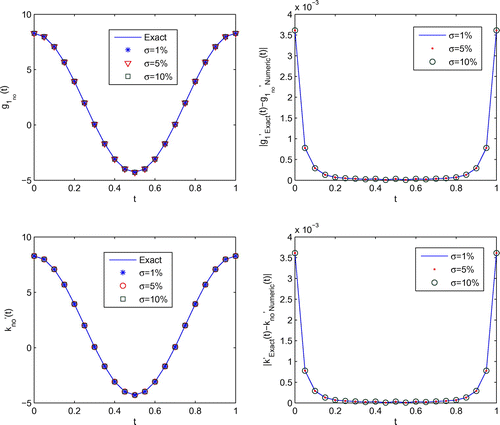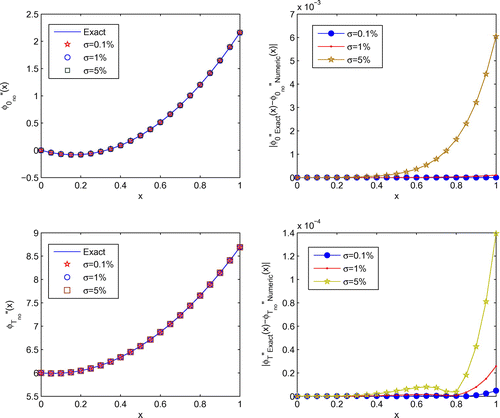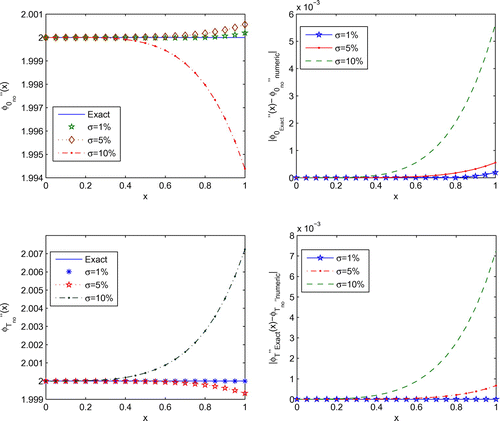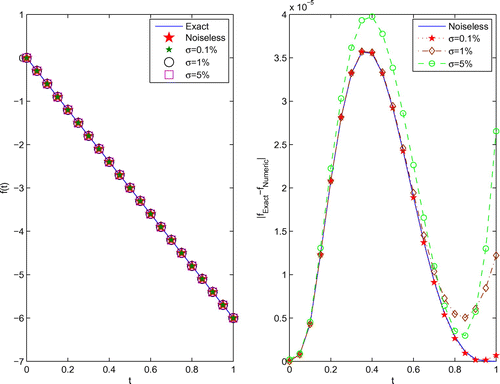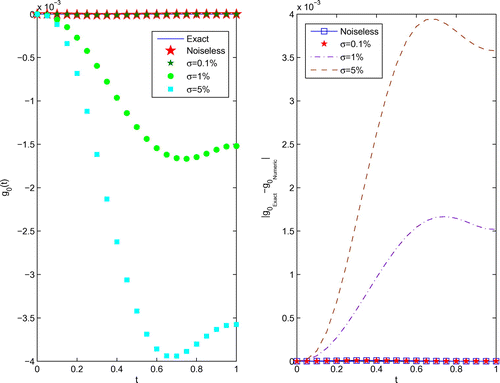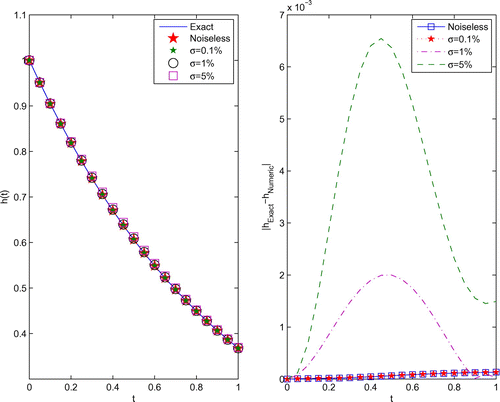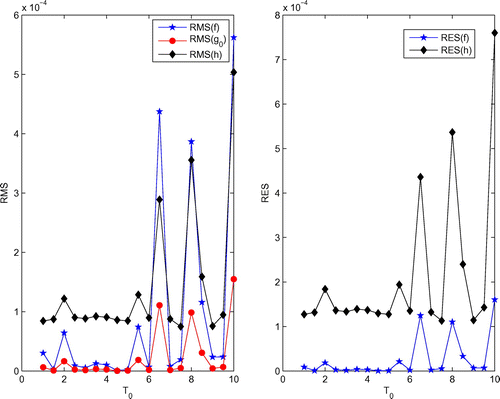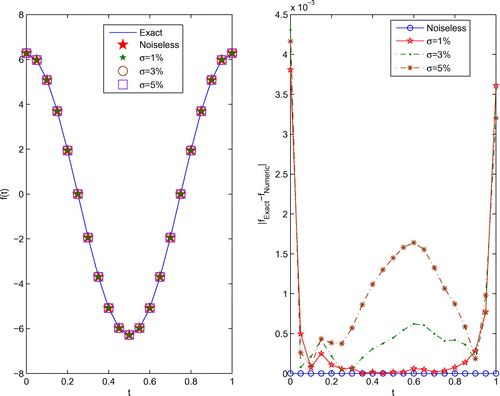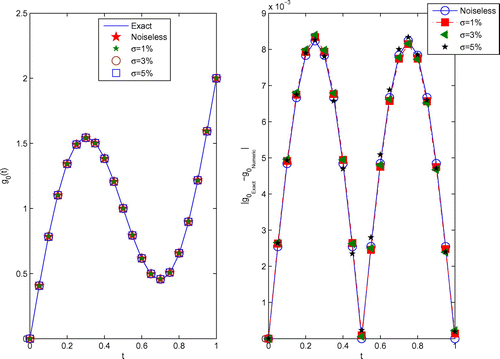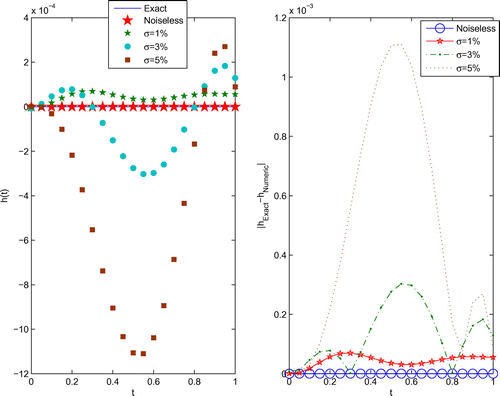 ?Mathematical formulae have been encoded as MathML and are displayed in this HTML version using MathJax in order to improve their display. Uncheck the box to turn MathJax off. This feature requires Javascript. Click on a formula to zoom.
?Mathematical formulae have been encoded as MathML and are displayed in this HTML version using MathJax in order to improve their display. Uncheck the box to turn MathJax off. This feature requires Javascript. Click on a formula to zoom.Abstract
A novel meshless numerical procedure based on the method of fundamental solutions (MFS) and the heat polynomials is proposed for recovering a time-dependent heat source and the boundary data simultaneously in an inverse heat conduction problem (IHCP). We will transform the problem into a homogeneous IHCP and initial value problems for the first-order ordinary differential equation. An improved method of MFS is used to solve the IHCP and a finite difference method is applied for solving the initial value problems. The advantage of applying the proposed meshless numerical scheme is producing the shape functions which provide the important delta function property to ensure that the essential conditions are fulfilled. Numerical experiments for some examples are provided to show the effectiveness of the proposed algorithm.
1. Introduction
In this paper, we consider the inverse problem of determination a time-dependent heat source and boundary data, simultaneously, in the following parabolic problem:(1)
(1)
(2)
(2)
(3)
(3)
(4)
(4)
where T is final time, c is a constant and the functions and
are known and continuous in their domains, while the heat source function f(t), the boundary temperature
and the heat flux
are unknowns to be determined from the following additional data:
(5)
(5)
(6)
(6)
The mathematical model (1)–(6) arises in various physical and engineering setting, in particular, in hydrology, material sciences, heat transfer and transport problems. A typical example is groundwater pollutant source estimation in cities with large populations. In this application, it is crucial to accurately identify which companies are responsible for the contamination [Citation1].
In the context of heat conduction and diffusion, where U represents temperature and concentration, the unknown f(t) is interpreted as a heat and material source, respectively, and in a chemical or a biochemical application, f(t) may be interpreted as a reaction term [Citation2]. Although the result in this paper applies to each of these interpretations, the unknown function f(t) will be referred to as a heat source term.
1.1. A brief review of methods existing in the literature
The inverse problem of determining an unknown heat source function in the heat conduction equation has been considered in many theoretical papers, notably [Citation3–Citation7]. The authors of [Citation3], proved the existence and uniqueness of an inverse source problem where the heat source is the product of a space function and a time function. The uniqueness solution of the inverse space-wise dependent heat source problem was considered in [Citation8–Citation11]. Also, this problem is investigated numerically by several authors. Authors of [Citation12,Citation13] used the method of fundamental solutions (MFS) to solve this problem. The boundary element method (BEM) [Citation14], iterative regularization methods [Citation15–Citation17] and finite difference technique [Citation18] are proposed to treated this problem. In [Citation19], an iterative algorithm based on the landweber regularization framework, is proposed to obtain the numerical solution of the problem. In [Citation20], the heat source is a function of both space and time but is separable and the space-dependent source term is recovered with He’s variational iteration method. However, many researchers sought the source as a function of time only [Citation21]. In [Citation22], this problem was studied with the finite difference method. Numerical solution is also considered by use of the MFS in [Citation23]. Authors of [Citation14] applied BEM to treat this problem. In [Citation1] authors used the method of simplified Tikhonov regularization (TR) for dealing with the inverse time-dependent heat source problem. Author of [Citation24] solved the problem with He’s variational iteration method. In [Citation25,Citation26], the author identified the heat source as time dependent only, by the Lie-group shooting method (LGSM). A BEM combined with the TR of various orders is developed in order to obtain a stable solution in [Citation27]. The method of central difference for the inverse time-dependent heat source problem is proposed in [Citation28]. Authors of [Citation29] considered the problem of identifying an unknown heat source depending simultaneously on both space and time variables. First the problem is transformed into an optimization problem and the uniqueness of minimum element is proved rigorously. Then, a variational formulation for solving the optimization problem is given. A conjugate gradient method and a finite difference method are used to solve the variational problem. Author of [Citation30] used the MFS and radial basis functions (RBFs) to solve the problem when source is a function of space and time. First for the approximation of time derivative in the governing equation, the finite difference method is used. Then, the problem is solved by the solution of non-homogeneous equation at each time step. The RBF is used for interpolation of right-hand side of the governing equation and obtaining a particular solution. In [Citation31], the identification of sources in steady-state heat conduction problem was considered without restriction for the form of heat sources, but some information about temperature in some inner point in considered region was used. Author employed the MFS to recover heat source in this problem. Besides, a sequential method in [Citation32], a linear least-squares error method in [Citation33], the Green element method [Citation34], the Lie-group differential algebraic equations method [Citation35], a iterative method [Citation36], a mollification regularization method [Citation37] and the conjugate gradient method [Citation38] are applied to the numerical solution of inverse heat source problems.
1.2. An introduction about MFS
The MFS is a meshless/meshfree boundary collocation method which is applicable to boundary value problems for which a fundamental solution of the operator in the governing equation is known. In spite of this restriction, it has, in recent years, become very popular primarily because of the ease with which it can be implemented, in particular for problems in complex geometries [Citation39]. This meshless method requires neither domain discretization as in the FEM and FDM, nor boundary discretization as in the BEM, thus it improves the computational efficiency and can be easily extended to solve high-order and high-dimensional differential equations [Citation13].
Kupradze and Aleksidze [Citation40] first proposed the concept of the MFS, and then Mathon and Johnston [Citation41] used the MFS to numerically solve the elliptic boundary value problems. Bogomolny [Citation42] established the preliminary mathematical framework for the MFS and fixed the positions of the source distribution.
Since then, there have appeared numerous reports on MFS for computation, see the reviews of the MFS in Fairweather and Karageorghis [Citation43], Golberg and Chen [Citation44], and a systemic introduction on the MFS in Chen et al. [Citation45]. The MFS has been applied to Cauchy and Stokes problems in [Citation46,Citation47], the biharmonic equation in [Citation43,Citation48] and even to a non-linear Poisson problem [Citation49]. Some important properties of the MFS were addressed by Schaback [Citation50]. Recently, the MFS has been successfully applied to solve the inverse problems associated with the heat equation [Citation51], linear elasticity [Citation52,Citation53], steady-state heat conduction in functionally graded materials [Citation54], Helmholtz-type equations [Citation55–Citation57] and source reconstruction in steady-state heat conduction problems [Citation58]. The steady Stokes flow problems were also solved using the steady Stokeslets [Citation59]. Golberg [Citation60] and Golberg et al. [Citation61] further extended the MFS to find a particular solution for the inhomogeneous term of the Poisson equation, using the method of particular solutions. Young et al. [Citation62] solved the time-dependent diffusion equation by the diffusion fundamental solution without temporal finite difference discretization. A new meshless singular boundary method, based on the notion of the BEM and the MFS, is introduced for solving three-dimensional inverse heat conduction problems (IHCPs) and large-scale three-dimensional potential problems in [Citation63,Citation64], respectively.
In this paper, a modified MFS (MMFS) is proposed for solving the IHCP (1)–(6). The method is based on the use of the fundamental solutions of heat equation and heat polynomials. The major advantage of MMFS is that the shape functions created possess the Kronecker delta function property.
The rest of the paper is as follows: In Section 2, the mathematical formulation of the problem is presented. Section 3 is devoted to the numerical procedure, a modified MFS method. In Section 4, Implementation of the proposed method is given. Error analysis is reported in Section 5. Several numerical examples are presented in Section 6. Conclusion is finally discussed in Section 7.
2. Mathematical formulation
In order to use the MMFS to solve the problem (1)–(6), the first goal is finding a new transformation which reduces the problem (1)–(6) to a PDE containing only one unknown function.
Let us define the following suitable transformation:(7)
(7)
According to (7), the problem (1)–(6) is changed to the following problem:(8)
(8)
(9)
(9)
(10)
(10)
(11)
(11)
(12)
(12)
(13)
(13)
Eliminating the unknown function f(t) in (11) and (12), we know the W satisfies the following equation:(14)
(14)
Then, we can propose a computational method for recovering the heat source and the boundary data by solving three problems.
Problem 1:
At first, we use a modified MFS to solve the following IHCP:(15)
(15)
(16)
(16)
(17)
(17)
(18)
(18)
By solving the inverse problem (15)–(18), we obtain the approximate values of and
. Then, we can determine the heat source using Equation (Equation11
(11)
(11) ) as follows:
(19)
(19)
Problem 2:
From (2) and (10), we know that the boundary data can be recovered by solving the following problem for ordinary partial equation:
(20)
(20)
(21)
(21)
Problem 3:
Now from (7) and (1), we obtain . Then by considering
and from (2), the boundary data h(t) can be determined by solving the following ordinary problem:
(22)
(22)
(23)
(23)
For the well-posed problems 2 and 3, we solve them in the next section by a finite difference method.
The solution of the inverse problem (15)–(19) is unstable. To show that we construct an example.
Let ,
and
The solution of the problem (15)–(19) when
is given by Therefore, we have
but
This indicates that although the data tends to zero, the solution f is unbounded. In other words, the inverse time-dependent heat source problem (1)–(6) is ill-posed.
3. Methodology
3.1. Heat Polynomials
We consider a solution w of heat equation(24)
(24)
in the form [Citation65], Chapter 1, p.16–18]:(25)
(25)
Upon substituting (25) into (24) and dividing through by , it follows that:
where is a complex constant. Solving the resulting ordinary differential equations
we obtain:(26)
(26)
By expanding Equation (Equation26(26)
(26) ) into a Taylor’s series with respect to
, we obtain:
(27)
(27)
where are the heat polynomials which hold in Equation (Equation24
(24)
(24) ).
An explicit formula for can be obtained from Cauchy’s multiplying two power series together, since
Setting
where
and
it follows that:(28)
(28)
where(29)
(29)
Here, denotes the largest integer less than or equal to
. From Equations (Equation26
(26)
(26) )–(Equation29
(29)
(29) ), it is clear that:
(30)
(30)
3.2. A modified MFS
Choose source points , then we can express an approximate solution given by a linear combination of the fundamental solutions of heat equation and the heat polynomials as follows:
(31)
(31)
where is the time shift function given by
,
, F is the fundamental solution of heat equation, H is the Heaviside function and
is a constant. Also,
is the heat polynomial and
and
are unknowns.
To determination the coefficients and
, the collocation method is used. However, in addition to the n equations resulting from collocating (31) at the n points
as follows:
(32)
(32)
extra m equations are required. This is insured by the following m conditions,(33)
(33)
The representation Equations (Equation32(32)
(32) ) and (Equation33
(33)
(33) ) constitute a
system of linear algebraic equations which can be expressed in matrix form as follows:
(34)
(34)
or(35)
(35)
where
If the inverse of matrix exists, a unique solution is obtained as:
(36)
(36)
Accordingly, Equation (Equation31(31)
(31) ) can be rewritten as
(37)
(37)
or(38)
(38)
where the matrix of shape functions is defined by
(39)
(39)
in which
and is the (i, k)th element of matrix
. The shape function
, obtained through the above process, possesses the following properties:
| (1) | Linear independence Shape functions are linearly independent in the desired domain. The shape function | ||||
| (2) | Partitions of unity | ||||
| (3) | Linear reproducibility | ||||
| (4) |
| ||||
| (5) | The shape function | ||||
4. Implementation of the proposed method
To apply the proposed method to the solution of problem (15)–(18), let be a set of scattered nodes such that
, where
(40)
(40)
(41)
(41)
(42)
(42)
We assume that an approximation to the solution of the problem (15)–(18) can be expressed as follows:(43)
(43)
where are the shape functions (39) and
are unknowns which remain to be determined.
For this choice of basis functions ; the approximate solution
already satisfies the heat Equation (Equation15
(15)
(15) ). The resultant linear system of equations for the unknown coefficients
can then be obtained from the following simple collocation.
Collocating Equation (Equation43(43)
(43) ) into (Equation40
(40)
(40) )–(Equation42
(42)
(42) ), we obtain
So we have the following linear system of equations:(44)
(44)
where
where ,
,
and
.
4.1. Regularization
As a direct consequence of the fact that the inverse problem (1)–(4), is highly ill-posed, the discretization matrix is severely ill-conditioned. Hence, a direct approach for solving the resulting system of linear algebraic Equation (Equation44
(44)
(44) ), such as the least-square method, would produce highly oscillatory and unbounded solutions, i.e. unstable solutions. The accurate and stable solution of the system of linear algebraic Equation (Equation44
(44)
(44) ) is very important for obtaining physically meaningful numerical results [Citation66]. Regularization methods are among the most popular and successful methods for solving stably and accurately ill-conditioned matrix equations [Citation67]. Here, we apply the standard TR technique [Citation66]. It consists of solving the optimization problem:
(45)
(45)
where denotes the usual Euclidean norm and
is called the regularization parameter. Formally, for a given value of the regularization parameter,
, Tikhonov regularized solution
of the problem (44) is obtained by solving the normal equation:
namely:
The choice of a suitable value of the regularization parameter is crucial for the accuracy of the final numerical solution and is still under intensive research [Citation68].
One parameter choice criterion extensively studied is the discrepancy principle [Citation69], however, it requires a reliable estimation of the amount of noise in the data. Heuristical approaches are preferable in the case when no a priori information about the noise is available. For the TR method, several heuristical approaches have been proposed, including the L-curve criterion [Citation70], cross-validation (CV) and generalized cross validation (GCV) [Citation71]. In this paper, we use the GCV to choose the regularization parameter. In GCV the regularization parameter chosen to minimize the GCV function:
where
Denote the solution of Equation (Equation45(45)
(45) ) by
. Then, the approximate solution for inverse problem (15)–(18) is
(46)
(46)
and the approximate heat source is(47)
(47)
From (46), we obtain and
. Then, the approximate boundary data
can be obtained by solving the following problem:
(48)
(48)
(49)
(49)
In order to solve the problem (48) and (49) numerically, we use the following formula (theta-method [Citation72]) for Equation (Equation48(48)
(48) ) which is in the form
where and
The approximate values of boundary data
can be obtained by solving the following problem:
(50)
(50)
(51)
(51)
Using theta-method for Equation (Equation50(50)
(50) ), we have
where and
The theta-method is of order two for and otherwise of order one.
Theorem 1:
The theta-method is convergent for every
Proof See [Citation72].
5. Error analysis
Suppose that and
, where
,
, the shape function
are given by (39) and
and u be an arbitrary element in H. Since Y is a finite dimensional vector space, u has the unique best approximation out of Y such as
; that is [Citation73]:
Since , there exists the unique coefficients
such that
Figure 13. Graph of and RES(f), RES(h) with noiseless data when
and various values of
for Example 2.
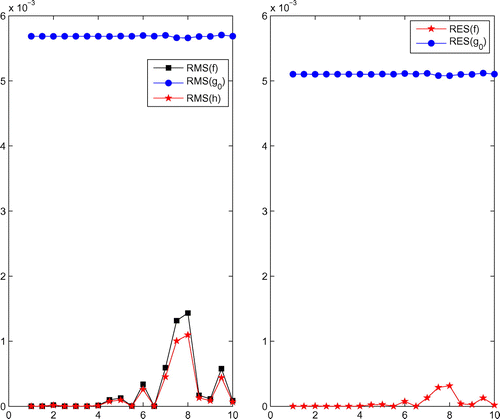
Theorem 2:
Let be a Hilbert space and Y be a closed subspace of H such that
and
is any basis for Y. Let u be an arbitrary element in H and
be the unique best approximation to u out of Y then [Citation73]:
where
Note that the inner product in space H is defined as follows:
and the norm is as follows:
Define
where
and
In the following we obtain bounds for the error of best approximation for heat source f(x) in terms of Sobolev norms. This norm for a function is defined in the interval (a, b) for
by
where denotes the kth derivative of
. The symbol
which is introduced in [Citation74] is defined by
Table 1. The values of RMS(f), RES(f), ,
, RMS(h) and RES(h) with different choose of n and m when
and
for Example 1.
Table 2. The values of RMS(f), RES(f), ,
, RMS(h) and RES(h) with different choose of
when
and
for Example 1.
Table 3. The values of RMS(f) and RES(f) for various values of ,
,
and
for Example 1.
To state our main results, the following Theorem will be required.
Theorem 3:
Suppose that with
. If
is the best approximation of
then
(52)
(52)
and for (53)
(53)
where c depends on
Proof Mashayekhi et al. [Citation75] Let with
and
be the best approximation of
which is constructed using shifted Legendre polynomials
in the interval [0, 1]. Then [Citation74]
(54)
(54)
and for (55)
(55)
Since the best approximation is unique [Citation73], we have(56)
(56)
and using Equations (Equation54(54)
(54) )–(Equation56
(56)
(56) ) we can obtain Equations (Equation52
(52)
(52) ) and (Equation53
(53)
(53) ).
Table 4. The values of RES(f) for various values of and
when
and
for Example 1.
Table 5. The values of RMS(f), RES(f), ,
, RMS(h) and RES(h) with different choose of n and m when
and
for Example 2.
Table 6. The values of RMS(f), RES(f), ,
, RMS(h) and RES(h) with different choose of
when
and
for Example 2.
Table 7. The values of RES(f) for various values of and
when
and
for Example 2.
In the following Theorems, we obtain error for the approximation functions and h(t) in Equations (Equation19
(19)
(19) )–(Equation23
(23)
(23) ).
Theorem 4:
Suppose that with
and
be the best approximation of W(1, t) then
and for ,
where a depends on .
Proof Consider be the best approximation of W(1, t) then
where
, is the best approximation of
. Now by using Equations (Equation19
(19)
(19) ) and (Equation52
(52)
(52) ) we have:
and for , using Equations (Equation19
(19)
(19) ) and (Equation53
(53)
(53) ) we obtain:
Theorem 5:
Suppose that with
and
and
and
, where
, be the best approximations of
and
, respectively. Then
and for ,
where a depends on .
Proof From Equations (Equation19(19)
(19) )–(Equation21
(21)
(21) ) and by integrating of (20) we get:
(57)
(57)
Suppose that and
be the best approximations of
and
, respectively, therefore
(58)
(58)
where . Then using Equations (Equation52
(52)
(52) ) and (Equation58
(58)
(58) ), we have:
and for , using Equations (Equation53
(53)
(53) ) and (Equation58
(58)
(58) ), we obtain:
Theorem 6:
Suppose that with
and
, where
and
, be the best approximation of
then
and for ,
where a depends on .
Proof From Equations (Equation22(22)
(22) )–(Equation23
(23)
(23) ) and by integrating of (22) we get:
(59)
(59)
Suppose be the best approximation of
then using Equations (Equation52
(52)
(52) ) and (Equation59
(59)
(59) ) we have:
Also for , by using Equations (Equation53
(53)
(53) ) and (Equation59
(59)
(59) ), we obtain:
6. Numerical examples
The inverse problems investigated in this study have been solved using a uniform distribution of the source and collocation points as where
. As always with inverse and improperly posed problems, behaviour of the numerical solution in the process of noise is an important part of the stability testing process [Citation76]. Thus, we consider some of the supplemented boundary conditions contaminated with errors. For more clarifications, in the numerical calculations we apply the noisy data
where and
are the exact data and rand(1) is a random number between (0, 1) and the magnitude
indicates the noise level of measurement data.
To obtain the stable numerical derivatives and
we use the regularized RBF methods in [Citation77,Citation78] to compute them and then the corresponding noisy right-hand side is denoted by
According to Theorem 2.2 in [Citation78], we consider
and
, separately, to be a linear combination of the Gaussians function
and polynomials
In two following examples, we take
. Figure presents the values of
and
with various values of polynomials
and scattered points
for Example 1. From this figure the numerical results with increasing
and
have become better. In Figures and the values of
and
and absolute errors
and
for various values of
are given. Also, the values of
and
and absolute errors
and
are shown in Figures and . We take
and
in Figures –. It can be seen from these figures that the stable numerical derivatives
and
are obtained.
In all following examples we set the scattered nods as and
, where
,
,
To test the accuracy of the approximate solution, we use the root mean square error (RMS) and the relative root mean square error (RES) defined as follows:
where is total number of testing points in the domain
and
are the exact and approximate values at this point, respectively.
Example 1:
Consider the problem (1)–(6) with and with the following initial, boundary and overspecified conditions [Citation23]:
The exact solution of this problem is:
The numerical results for the heat source with various relative noise levels are illustrated in Figure , and the corresponding boundary temperature and boundary heat flux are presented in Figures and , respectively. Compared Figure with Figure in [Citation23], the results by our method are more accurate.
The error distribution for the numerical heat source, boundary temperature and boundary heat flux obtained for using various amounts of noise added into the data, are also presented in Figures –. It can be seen from these Figures that the numerical results retrieved for the heat source, boundary temperature and boundary heat flux represent good approximations for their analytical values. Furthermore, the numerical heat source, boundary temperature and boundary heat flux converge towards their corresponding exact solutions as the amount of noise decreases.
To show the influence of the parameters , we compute the RMS and RES for the heat source, boundary temperature and boundary heat flux with various
for noiseless data,
and
, and the numerical results are shown in Figure . It can be seen from this figure that the accuracy of the numerical results is relatively independent of the parameter
if
. The insensitivity of the solutions to
over fairly large ranges of the parameters is a favourable feature of MMFS because there is no need to search for optimal values of parameters.
To see the effectiveness of the collocation points and the source points, we present the RMS and RES for the heat source, boundary temperature and boundary heat flux with varying the numbers of collocation and source points for a fixed noise level in Tables and . It can be seen from Table that the numerical errors for the heat source, boundary temperature and boundary heat flux mainly depend on the number
and
for a fixed
. In Table , setting
and varying
, we note that the numerical errors for the heat source, boundary temperature and boundary heat flux are almost constants.
Also in Table , we give the RMS and RES for the heat source, boundary temperature and boundary heat flux to show the advantage of adding the heat polynomials in Equation (Equation31(31)
(31) ) by choosing the various values of m. From this table, we see that the new method combined with the heat polynomials is more accurate than the pure MFS and adding some heat polynomials make the results more precise.
Next, we analyse the accuracy of the numerical method proposed with respect to the parameter . To do that, we set
for Example 1. Table illustrate the errors RES(f) with various relative noise levels
. From this Table we will see that the numerical errors almost keep a stable level.
To compare our method with MFS [Citation23], the error of RMS and RES for the heat source with and various values of
are tabulated in Table . Also, the error of RES for the heat source with various relative noise level are illustrated in Table . It can be observed from Tables and that the numerical errors calculated from our method are more less than MFS [Citation23].
Example 2:
Let us consider the problem (1)–(6) with and with the following initial, boundary and overspecified conditions [Citation23]:
The exact solution of this problem is:
The exact and numerical results for the heat source, boundary temperature, boundary heat flux and their corresponding error distributions obtained with noises added into the data are shown in Figures –, respectively, It can be seen from these Figures that the numerical results are in good agreement with their corresponding exact solutions. Comparing with the results presented in Figure of [Citation23], we conclude that our MMFS approximation are more accurate and stable than that the results in [Citation23].
The RMS and RES for the heat source, boundary temperature and boundary heat flux for different values of ,
and
with noiseless data are reported in Figure . It can be observed from this figure that the MMFS approximation provide stable numerical results for
.
The values of and RES(h) for various values of source and collocation points are presented in Tables and . From these Tables, the MMFS depend on the number n for
and almost constants with increasing
for a fixed
.
Also, in Table some results for choosing various values of the heat polynomials in Equation (Equation31(31)
(31) ) are shown. From this table it can be seen that our method with some heat polynomials are more accurate than pure MFS.
To verify the relationship between the accuracy of solution and , we compute the RES(f) with various
,
and
, and the numerical results are shown in Table . We can see that the numerical errors keep a stable level. Furthermore, the values of RES(f) decrease as the level of noise
added into the input data decrease.
7. Conclusion
In this paper, a meshless method has been developed for obtaining a stable numerical solution to the inverse heat conduction problem. The new approach does not require any domain discretization or any boundary discretization as in FDM and FEM and also is a free integration method. Comparing with the pure MFS in Section 6, we conclude that the proposed method are more accurate.
It should be mentioned that the method used in our paper may be generalized to higher dimensional problems. For instance, we may consider the inverse problem in two or three dimension. A similar approach can be used to the solution of an IHCP in an anisotropic medium [Citation79] and to the solution a time-dependent two-dimensional Cauchy heat conduction problem [Citation80]. One may consider this method to the solution one or two-phase Stefan problem [Citation76]. Also, the main idea behind the new approach can be investigated to solve the partial differential equations studied in [Citation12–Citation15,Citation77].
Although we have only considered Dirichlet boundary condition, there are also solvability theorems for the problem of finding a source for the parabolic heat equation with general boundary conditions [Citation3]. The proposed method can be used for the determination of a single variable source for the heat conduction equation in another inverse formulation, with an integral over determination condition specifying the energy variation of the heat-conducting system [Citation3,Citation14].
Future work will be concerned with the numerical determination of a source or
in the following reaction–diffusion–convection equation:
(60)
(60)
where K, v and are constants. Other possible future work may also concern the numerical determination of a source of the type
or
Acknowledgements
Authors are very grateful to reviewer for carefully reading the paper and for his/her comments and suggestions which have improved the paper.
Notes
No potential conflict of interest was reported by the authors.
References
- Yang F, Fu CL. The method of simplified Tikhonov regularization for dealing with the inverse time-dependent heat source problem. Comput Math Appl. 2010;60(5):1228–1236.
- Liu J, Wang B, Liu Zh. Determination of a source term in a heat equation. Int J Comput Math. 2010;87(5):969–975.
- Savateev EG. On problems of determining the source function in a parabolic equation. J Inverse Ill-Posed Prob. 1995;3(1):83–102.
- Solov’ev VV. Solvability of the inverse problems of finding a source, using overdetermination on the upper base for a parabolic equation. Differ Equ. 1990;25:1114–1119.
- Cannon JR, Zachman D. Parameter determination in parabolic partial differential equations from over-specified boundary data. Int J Eng Sci. 1982;20:779–788.
- Prilepko AI, Solov’ev VV. Solvability theorems and Rote’s method for inverse problems for a parabolic equation. I Differ Equ. 1988;23:1230–1237.
- Rundell W. The determination of an unknown non-homogeneous term in linear partial differential equations from overspecifie data. Appl Anal. 1980;10:231–242.
- Cannon JR. Determination of an unknown heat source from overspecified data. SIAM J Numer Anal. 1968;5(2):275–286.
- Cannon JR, Duchateau P. Structural identification of an unknown source term in heat equation. Inverse Prob. 1998;14(3):535–551.
- Ling L, Yamamoto M, Hon YC, et al. Identification of source locations in two-dimentional heat equations. Inverse Prob. 2006;22(4):1289–1305.
- Alves CJS, Calaco MJ, Leitao VMA, et al. Recovery the source term in a linear diffusion problem by the method of fundamental solutions. Inverse Prob Sci Eng. 2008;16(8):1005–1021.
- Nili Ahmadabadi M, Arab M, Maalek Ghaini FM. The method of fundamental solutions for the inverse space-dependent heat source problem. Eng Anal Boundary Elem. 2009;33:1231–1235.
- Yan L, Yang F-L, Fu C-L. A meshless method for solving an inverse spacewise-dependent heat source problem. J Comput Phys. 2009;228:123–136.
- Farcas A, Lesnic D. The boundary-element method for the determination of a heat source dependent on one variable. J Eng Math. 2006;54:375–388.
- Johansson BT, Lesnic D. Determination of a spacewise dependent heat source. J Comput Appl Math. 2007;209:66–80.
- Johansson BT, Lesnic D. A variational method for identifying a spacewise-dependent heat source. IMA J Appl Math. 2007;72(6):748–760.
- Johansson BT, Lesnic D. A procedure for determining a spacewise dependent heat source and the initial temperature. Appl Anal. 2008;87:265–276.
- Yan L. C. L. Fu., F. F. Dou, A computational method for identifying a spacewise-dependent heat source, Int J Numer Methods. Biomed Eng. 2013;26(10):939–957.
- Yang L, Yu J-N, Luo G-W, et al. Numerical identification of source terms for a two dimensional heat conduction problem in polar coordinate system. Appl Math Model. 2010;37(3):597–608.
- Geng FZ, Lin YZ. Application of the variational iteration method to inverse heat source problems. Comput Math Appl. 2009;58(11–12):2098–2102.
- Yang L, Dehghan M, Yu JN, et al. Inverse problem of time-dependent heat sources numerical reconstruction. Math Comput Simul. 2011;81(8):1656–1672.
- Liu J, Wang B, Liu ZH. Determination of a source term in a heat equation. Int J Comput Math. 2010;87(5):969–975.
- Yan L, Fu CL, Yang FL. The method of fundamental solutions for the inverse heat source problem. Eng Anal Boundary Elem. 2008;32(3):216–222.
- Shahrezaee AM. A meshless Method for solving an inverse Time-dependent Heat Source Problem. J Sci Kharazmi Univer. 2013;13(2):363–372.
- Liu CH. A two-stage LGSM to identify time-dependent heat source through an internal measurement of temperature. Int J Heat Mass Transfer. 2009;52:1635–1642.
- Liu C-S. A Lie-group shooting method for reconstructing a past time-dependent heat source. Int J Heat Mass Transfer. 2012;55(5–6):1773–1781.
- Hazanee A, Ismailov MI, Lesnic D, et al. An inverse time-dependent source problem for the heat equation. Appl Numer Math. 2013;69:13–33.
- Yang F, Guo HZ, Li XX. The method of central difference for the inverse time-dependent heat source problem. Appl Math Comput. 2011;218(7):3025–3034.
- Ma Y-J, Fu C-L, Zhang Y-X. Identification of an unknown source depending on both time and space variables by a variational method. Appl Math Model. 2013;36(10):5080–5090.
- Mierzwiczak M, Kolodziej JA. Application of the method of fundamental solutions and radial basis functions for inverse transient heat source problem. Comput Phys Commun. 2010;181:2035–2043.
- Kolodziej JA, Mierzwiczak M, Cialkowski M. Application of the method of fundamental solutions and radial basis functions for inverse heat source problem in case of steady-state. Int Commun Heat Mass Transfer. 2010;37(2):121–124.
- Yang CY. A sequential method to estimate the strength of the heat source based on symbolic computation. Int J Heat Mass Transfer. 1998;41(14):2245–2252.
- Yang CY. Solving the two-dimensional inverse heat source problem through the linear least-squares error method. Int J Heat Mass Transfer. 1998;41(2):393–398.
- Akpofure E. Taigbenu. Inverse solutions of temperature, heat flux and heat source by the Green element method, Appl Math Model. 2015;39(2):667–681.
- Liu C-S. Finding unknown heat source in a nonlinear Cauchy problem by the Lie-group differential algebraic equations method. Eng Anal Boundary Elem. 2015;50:148–156.
- Shi C, Wang C, Wei T. Numerical solution for an inverse heat source problem by an iterative method. Appl Math Comput. 2014;244:577–597.
- Yang F, Fu C-L. A mollification regularization method for the inverse spatial-dependent heat source problem. J Comput Appl Math. 2014;255:555–567.
- Hào DN, Thanh PX, Lesnic D, et al. Determination of a source in the heat equation from integral observations. J Comput Appl Math. 2014;264:82–98.
- Marin L. A meshless method for the stable solution of singular inverse problems for two-dimensional Helmholtz-type equations. Eng Anal Boundary Elem. 2010;34:274–288.
- Kupradze VD. Potential methods in elasticity. In: Nauka M, editor. Prilozhenia teorii funktsii v mekhanike sploshnoi sredy. Trudy Mezhdunarodn. Simposiuma, Tbilisi, 1963. Solid mechanics. Vol. 1, 1965. p. 211–216
- Mathon R, Johnston RL. The approximate solution of elliptic boundaryvalue problems by fundamental solutions. SIAM J Numer Anal. 1977;14:638–650.
- Bogomolny A. Fundamental solutions method for elliptic boundary value problems. SIAM J Numer Anal. 1985;22:644–69.
- Fairweather G, Karageorghis A. The method of fundamental solutions for elliptic boundary value problems. Adv Comput Math. 1998;9:69–95.
- Golberg MA, Chen CS. The method of fundamental solutions for potential, Helmholtz and diffusion problems. In: Golberg MA, editor. Boundary integral methods -- Numerical and Mathematical Aspects. Computational Mechanics Publications; 1998. p. 103–176.
- Chen CS, Hon YC, Schaback RA. Scientific computing with radial basis functions, preprint. Department of Mathematics: University of Southern Mississippi, Hattiesburg (MS), USA; 2005.
- Ushijima T, Chiba F. A fundamental solution method for the reduced wave problem in a domain exterior to a disc. J Comput Appl Math. 2003;152:545–557.
- Shigeta T, Young DL. Method of fundamental solutions with optimal regularization techniques for Cauchy problem of the Laplace equation with singular points. J Comput Phys. 2009;228:1903–1915.
- Airweather G, Karageorghis A. The method of fundamental solutions for numerical solutions of the biharmonic equation. J Comput Phys. 1987;69:434–459.
- Balakrishnan K, Ramachandran PA. A particular solution for non-linear Poisson problems in heat and mass transfer. J Comput Phys. 1999;150:239–267.
- Schaback R. Adaptive numerical solution of MFS systems. A Plenary Talk at the First International Workshop on the Method of Fundamental Solutions (MFS2007), Ayia Napa, Cyprus, June 11–13. 2007.
- Hon YC, Wei T. A fundamental solution method for inverse heat conduction problem. Eng Anal Boundary Elem. 2004;28:489–495.
- Marin L, Lesnic D. The method of fundamental solutions for the Cauchy problem in two-dimensional linear elasticity. Int J Solids Struct. 2004;41:3425–3438.
- Marin L. A meshless method for solving the Cauchy problem in threedimensional elastostatics. Comput Math Appl. 2005;50:73–92.
- Marin L. Numerical solutions of the Cauchy problem for steady-state heat transfer in two-dimensional functionally graded materials. Int J Solids Struct. 2005;42:4338–4351.
- Marin L, Lesnic D. The method of fundamental solutions for the Cauchy problem associated with two-dimensional Helmholtz-type equations. Comput Struct. 2005;83:267–278.
- Marin L. A meshless method for the numerical solution of the Cauchy problem associated with three-dimensional Helmholtz-type equations. Appl Math Comput. 2005;165:355–374.
- Jin B, Zheng Y. A meshless method for some inverse problems associated with the Helmholtz equation. Comput Methods Appl Mech Eng. 2006;195:2270–2280.
- Jin B, Marin L. The method of fundamental solutions for inverse source problems associated with the steady-state heat conduction. Int J Numer Methods Eng. 2007;69:1570–1589.
- Young DL, Jane SJ, Fan CM, et al. The method of fundamental solutions for 2D and 3D Stokes problems. J Comput Phys. 2006;211:1–8.
- Golberg MA. The method of fundamental solutions for Poissons equations. Eng Anal Boundary Elem. 1995;16:205–213.
- Golberg MA, Muleshkov AS, Chen CS, et al. Polynomial particular solutions for certain partial differential operators. Numer Methods Partial Differ Equ. 2002;19(1):112–133.
- Young DL, Tsai CC, Murugesan K, et al. Time-dependent fundamental solutions for homogeneous diffusion problems. Eng Anal Boundary Elem. 2004;29:1463–1473.
- Gu Y, Chen W, Zhang C, et al. A meshless singular boundary method for three-dimensional inverse heat conduction problems in general anisotropic media. Int J Heat Mass Transfer. 2015;84:91–102.
- Gu Y, Gao H, Chen W, et al. Fast-multipole accelerated singular boundary method for large-scale three-dimensional three-dimensional potential problems. Int J Heat Mass Transfer. 2015;90:291–301.
- Cannon JR. The one-dimensional heat equation. Reading (MA): Addison Wesley; 1984.
- Marin L. A meshless method for the stable solution of singular inverse problems for two-dimensional Helmholtz-type equations. Eng Anal Boundary Elem. 2010;34:274–288.
- Tikhonov AN, Arsenin VY. Methods for slving ill-posed problems. Moscow: Nauka; 1986.
- Tautenhahn U, Hämarik U. The use of monotonicity for choosing the regularization parameter in ill-posed problems. Inverse Prob. 1999;15:1487–1505.
- Morozov VA. Methods for solving incorrectly posed problems. New York (NY): Springer; 1984.
- Hansen PC. Rank-deficient and discrete ill-posed problems. Philadelphia: SIAM; 1998.
- Golub G, Heath M, Wahba G. Generalized cross-validation as a method for choosing a good ridge parameter. Technometrics. 1979;21(2):215–223.
- Iserles A. A first course in the numerical analysis of differential equations. Cambridge University Press; 1996.
- Kreyszig E. Introductory Functional Analysis with Applications. New York (NY): Wiley; 1978.
- Canuto C, Hussaini MY, Quarteroni A, et al. Spectral methods: fundamentals in single domains. Berlin: Springer; 2006.
- Mashayekhi S, Ordokhani Y, Razzaghi M. A hybrid functions approach for the Duffing equation. Phys Scr. 2013;88(2):025002.
- Johansson BT, Lesnic D, Reeve T. A meshless method for an inverse two phase one-dimensional linear Stefan problem. Inverse Prob Sci Eng. 2013;21:17–33.
- Wei T, Wang JC. Simultaneous determination for a space-dependent heat source and the initial data by the MFS. Eng Anal Boundary Elem. 2012;36:1848–1855.
- Wei T, Hon YC, Ling L. Method of fundamental solutions with regularization techniques for Cauchy problems of elliptic operators. Eng Anal Boundary Elem. 2007;31(4):373–385.
- Dong CF, Sun FY, Meng BQ. A method of fundamental solutions for inverse heat conduction problems in an anisotropic medium. Eng Anal Boundary Elem. 2007;31:75–82.
- Reeve T, Tomas Johansson B. The method of fundamental solutions for a time-dependent two-dimensional Cauchy heat conduction problem. Eng Anal Boundary Elem. 2013;37:569–578.

